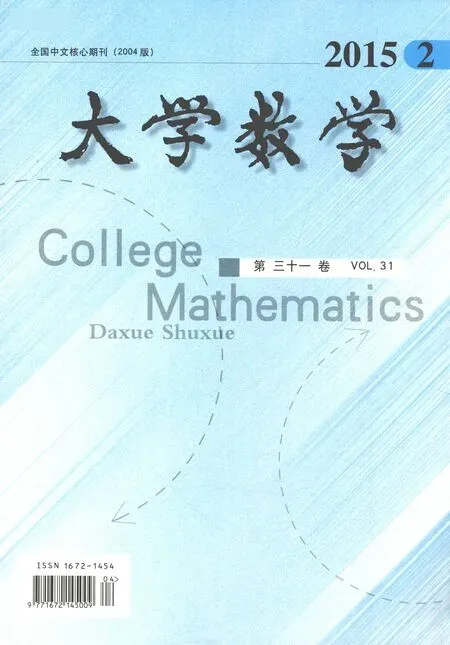Continued Fraction Estimates for the Psi Function with Application
-
(School of Mathematics and Informatics, Henan Polytechnic University, Jiaozuo, Henan 454000, China)
Continued Fraction Estimates for the Psi Function with Application
YANGCui-huan
(School of Mathematics and Informatics, Henan Polytechnic University, Jiaozuo, Henan 454000, China)
Abstract:We present continued fraction estimates for the psi function. As an application, we obtain the higher order estimate for the Euler-Mascheroni constant.
Key words:psi function; Euler-Mascheroni constant; inequality
CLC Number:O178Document Code:AArticle ID:1672-1454(2015)02-0001-04
1Introduction
The gamma function

is one of the most important functions in mathematical analysis and has applications in many diverse areas. The logarithmic derivative of the gamma function:

is known as the psi (or digamma) function.
The Euler-Mascheroni constant γ=0.577215664… is defined as the limit of the sequence
Dn=Hn-lnn,
(1.1)
where Hndenotes the nth harmonic number defined by

The following bounds for Dn-γ was established in [1,2]:

The convergence of the sequence Dnto γ is very slow. By changing the logarithmic termlnn in (1.1), some quicker approximations to the Euler-Mascheroni constant were established. For example, DeTemple[3]proved that

(1.2)
where

Negoi[4]proved that the sequence

(1.3)
is strictly increasing and convergent to γ. Moreover, the author proved that

(1.4)
It is well known (see [5, p. 258, Eq. (6.3.2)]) that
ψ(n+1)=-γ+Hn.
(1.5)
Hence, various approximations of the psi function are used in this relation and interpreted as approximation for the harmonic number Hnor as approximation of the constant γ.
In this paper, we present continued fraction estimates for the psi function. As an application, we obtain the higher order estimate for the Euler-Mascheroni constant.
The numerical values given in this paper have been calculated via the computer program MAPLE 13.
2Result
TheoremFor x>0,

(2.1)
ProofFrom the well known continued fraction for ψ′(see [6,p.373])

where

we find that for x>0,

(2.2)
that is

(2.3)
The proof of the inequality (2.1) makes use of the inequality (2.3).
The lower bound of (2.1) is obtained by considering the function f(x) which is defined, for x>0, by

Differentiating f(x) and applying the first inequality in (2.3), we obtain





with
a(x)=76038514949346075000+749239954971544664625x+12112741968830037017280x2
+33532128649853122898908x3+322523687037758203267200x4
+441328761789673154122768x5+3002883268104837305395200x6
+3149099605123021363170112x7+9915897695957660383119360x8
+6831088265743894299259392x9+11979641160431910991872000x10
+4430138616009014947799040x11+3985559142892178178539520x12
and


Hence, f′(x)<0 for x>0. This leads to

This means that the first inequality in (2.1) holds for x>0.
The upper bound of (2.1) is obtained by considering the function F(x) which is defined, for x>0, by

Differentiating F(x) and applying the second inequality in (2.3), we obtain





with
A(x)=672313330254641778527+28510966076012200640752x2
+207328581527078869127088x4+540041684255018773365888x6
+489581990105728423680000x8
and
B(x)=(4475520x4+2661600x2+74381)(18648x2+10313)(1008x4+1960x2+407)x9.
Hence, F′(x)>0 for x>0. This leads to

This means that the second inequality in (2.1) holds for x>0. The proof is complete.
From the above theorem, we obtain the following
CorollaryFor every integer n≥1, let

(2.4)
Then

(2.5)
This provides the higher order estimate for the Euler-Mascheroni constant. Obviously, the convergence of the sequence Ynto γ is quicker than the sequence Tndefined by (1.3).
[References]
[1]Rippon P J. Convergence with pictures [J]. Amer. Math. Monthly, 1986, 93 (6): 476-478.
[2]Young R M. Euler’s Constant [J]. Math. Gaz., 1991, 75: 187-190.
[3]De Temple D W. A quicker convergence to Euler’s constant [J]. Amer. Math. Monthly, 1993, 100 (5): 468-470.
[4]Negoi T. A faster convergence to the constant of Euler [J]. Gazeta Matematicǎ, seria A, 1997, 15: 111-113 (in Romanian).
[5]Abramowitz M, Stegun I A (Editors). Handbook of Mathematical Functions with figures, Graphs, and Mathematical Tables (Applied Mathematics Series 55)[M]. Washington D C: National Bureau of Standards, 1972.
[6]Wall H S. Analytic Theory of Continued Fractions [M]. New York: D. Van Nostrand Company.

